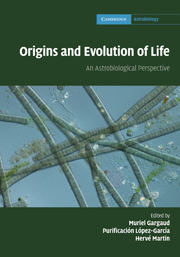Book contents
- Frontmatter
- Contents
- List of contributors
- Foreword
- Preface
- Part I What is life?
- Part II Astronomical and geophysical context of the emergence of life
- 6 Organic molecules in the interstellar medium
- 7 Cosmochemical evolution and the origin of life: insights from meteorites
- 8 Astronomical constraints on the emergence of life
- 9 Formation of habitable planets
- 10 The concept of the galactic habitable zone
- 11 The young Sun and its influence on planetary atmospheres
- 12 Climates of the Earth
- Part III The role of water in the emergence of life
- Part IV From non-living systems to life
- Part V Mechanisms for life evolution
- Part VI Life in extreme conditions
- Part VII Traces of life and biosignatures
- Part VIII Life elsewhere?
- Index
9 - Formation of habitable planets
from Part II - Astronomical and geophysical context of the emergence of life
Published online by Cambridge University Press: 04 February 2011
- Frontmatter
- Contents
- List of contributors
- Foreword
- Preface
- Part I What is life?
- Part II Astronomical and geophysical context of the emergence of life
- 6 Organic molecules in the interstellar medium
- 7 Cosmochemical evolution and the origin of life: insights from meteorites
- 8 Astronomical constraints on the emergence of life
- 9 Formation of habitable planets
- 10 The concept of the galactic habitable zone
- 11 The young Sun and its influence on planetary atmospheres
- 12 Climates of the Earth
- Part III The role of water in the emergence of life
- Part IV From non-living systems to life
- Part V Mechanisms for life evolution
- Part VI Life in extreme conditions
- Part VII Traces of life and biosignatures
- Part VIII Life elsewhere?
- Index
Summary
Characteristics of a habitable planet
What is a habitable planet? There is no formal definition at present, but the term is generally understood to mean a planet that can sustain life in some form. This concept is of limited use in practice since the conditions required to support life are poorly constrained. A narrower definition of a habitable planet is one that shares some characteristics with Earth, and hence one that could support at least some of Earth's inhabitants. A commonly adopted minimum requirement is that a planet can sustain liquid water on its surface for geological periods of time. Earth is the only body in the Solar System that qualifies as habitable in this sense. One advantage of this definition is that it can be used to categorize hypothetical and observable planets in a relatively straightforward manner, and we will use it in the rest of this chapter. However, one should bear in mind that not all life-sustaining environments will be included under this definition. Tidally heated satellites of giant planets, like Europa, are likely to possess oceans of liquid water beneath a layer of ice (Cassen et al., 1979), but these objects would not be ‘habitable’ according to the conventional usage.
Planets that can support liquid water at their surface must have an atmosphere, and surface temperatures and pressures within a certain range. These planets will occupy a particular range of orbital distances from their star that is commonly referred to as the star's habitable zone (HZ).
- Type
- Chapter
- Information
- Origins and Evolution of LifeAn Astrobiological Perspective, pp. 136 - 153Publisher: Cambridge University PressPrint publication year: 2011



